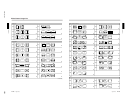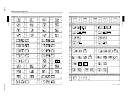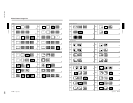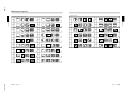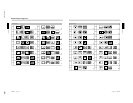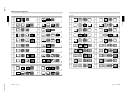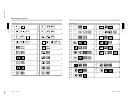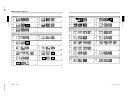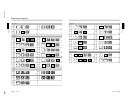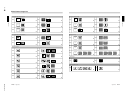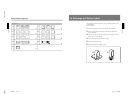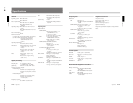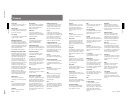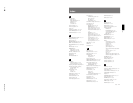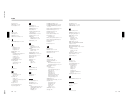
1-103
DFS-700/700P
Appendixes
A-66
Appendixes
Glossary
Glossary
A-roll edit
An edit using one player and one
recorder for basic cut editing.
A/B roll edit
An edit using two players and one
recorder, to permit special effects
such as mix and wipe.
B–Y signal
A color difference signal. The blue
signal minus the Y signal.
Background picture
In animation effects, the picture
into which the foreground picture
is inserted. In transition effects, the
picture that is replaced as the effect
progresses (FROM picture). The
picture selected with the
BACKGROUND bus buttons.
Background through mode
In the DFS-700/700P, an output
mode in which the video input of
the background bus and the video
input of the foreground bus are
mixed for output. Normally the
two pictures are delayed by 1
frame, but in pre-read editing the
background bus picture is delayed
by 4 lines. Pre-read editing is
enabled by inserting the input of
the background bus into the output
of the recorder VTR. In this state,
the foreground bus input delay
becomes 1 frame + 4 lines.
Therefore, the VTR output that is
inserted into the foreground bus
must be read ahead by 1 frame.
Black burst
A sync signal composed of
composite sync and burst signals.
Bus
An internal signal path. Signals
selected for input to the bus are
passed on to the next process.
Chroma
In colors, hue and saturation.
Chroma key
Key effect in which a particular
color (usually a highly saturated
blue) is used to cut holes in a
background picture.
Color bar
A test signal displayed on a
monitor screen as vertical stripes
of different colors, used to adjust
hue and saturation.
Color matte
An internally generated color
signal with adjustable hue,
saturation, and luminance.
Component signal
Video signal containing separate
luminance (Y) and color difference
(R–Y, B–Y) video components.
Composite signal
Video signal containing video,
color burst, and sync signals.
Cross-point
An electronic switch where video
signal lines cross. When the switch
is closed, usually by pressing a
button, multiple input signals and
one or more output signals are
allowed to pass.
Cut
An instantaneous switch from one
picture to another, or the
instantaneous insertion or deletion
of a key signal.
Downstream key (DSK)
Effect used to superimpose
characters or graphics over output
signals. Called downstream key
because superimposing takes place
in the final stages of processing
after other effects have been
applied. Requires a key source
signal to define the outlines of the
characters or graphics, and a key
fill signal to fill the outlines. See
also “title key”.
Editing control unit
A video editor with functions for
remote control of VTRs, video
switchers, audio switchers, and
other video editing equipment.
Field
In the NTSC color television
system, 262.5 horizontal scanning
lines. Odd lines are scanned for the
first field before returning to the
top of the screen to scan even
lines. A frame is composed of two
fields: the odd and even fields.
Foreground picture
In animation effects, the picture
inserted into the background
picture. In transition effects, the
picture left on the screen after the
effect finishes (TO picture). The
picture selected with the
FOREGROUND bus buttons.
Frame
Two fields, containing all the
information in a complete picture.
Frame synchronizer
A device used to bring the timing
of unsynchronized video into
conformance with a local reference
signal.
Gen-lock
To synchronize output signals to
an external sync signal.
GPI
Abbreviation of general purpose
interface. An interface used to
carry out remote control from
editing control units lacking a
formal interface.
Hue
The attribute of colors that allows
them to be classified as red, green,
blue, and so on. Red and pink have
the same hue, but different
saturations.
Appendixes
Appendixes
A-67
Key clip
In luminance keys, to specify a
reference luminance level. The
part of the signal above the
reference level is used as the key
source signal. See also “key
source”.
Key fill
A signal used to fill the hole cut
with the key source signal.
Key frame
User program effect data which
defines the effect at a specific
point. User program effects are
made up of sequentially executed
key frames.
Key gain
The sensitivity of circuits, which
can be adjusted with the switcher’s
key gain control. This is done to
obtain the desired blurring of key
edges.
Key invert
In luminance key, to reverse the
polarity of a key source signal so
that the hole is cut with the darker
part of the signal.
Key mask
To hide part of a title key or
downstream key signal so that only
the desired part is used.
Key source
A signal used to cut a hole in a
background picture for insertion of
a key fill signal.
Luminance key
Key effect in which a luminance
signal is used to define the outlines
of characters or graphics.
Luminance signal
The part of a video signal that
carries brightness information.
Also called the Y signal.
Mix
Effect in which one signal fades in
while another fades out. Also
called dissolve.
Pre-read editing
A/B roll editing using the output
(playback) of the recorder VTR
and a player VTR.
Preroll
Running a videotape a certain
distance before the edit IN point in
order to bring the tape to a steady
speed and synchronize it with
other tapes.
Postroll
Running a videotape a certain
distance past the edit OUT point in
order to monitor the video that
follows.
R–Y signal
A color difference signal. The red
signal minus the Y signal.
RGB signal
A signal format in which red,
green, and blue signals are
transmitted separately. A separate
sync signal may be sent, or the
sync signal can be added to the
green signal. The DFS-700/700P
uses the latter method.
Saturation
The extent to which a color has
been diluted by white. Pure red is
fully saturated, while pink is
diluted.
SDI
A serial component digital signal.
S-video signal
A video signal with separate
luminance (Y) and chrominance
(C) components. As opposed to
composite video, S-video provides
higher quality by eliminating
interference between the Y and C
signals.
Snapshot
Data containing the settings of
specific controls on the control
panel. Snapshots can be saved and
recalled to restore the control panel
to a desired state.
Subcarrier (SC)
The part of a video signal that
carries color information. The
amplitude represents saturation,
and the relative phase against the
color burst signal represents hue.
Also called the color subcarrier.
Title key
Effect used to superimpose
foreground characters or graphics
on a background. Requires a key
source signal to define the outlines
of the characters or graphics, and a
key fill signal to fill the outlines.
See also “downstream key”.
Transition
A period during which one picture
is replaced by another, or a period
during which a key is inserted or
deleted.
Wipe
A transition effect in which one
picture moves in to replace
another. Often the new picture
appears as a geometrical shape
such as a circle or star.
YUV signal
An analog component signal,
consisting of a luminance (Y)
signal, a color difference signal U
(B–Y) and a color difference signal
V (R–Y).



